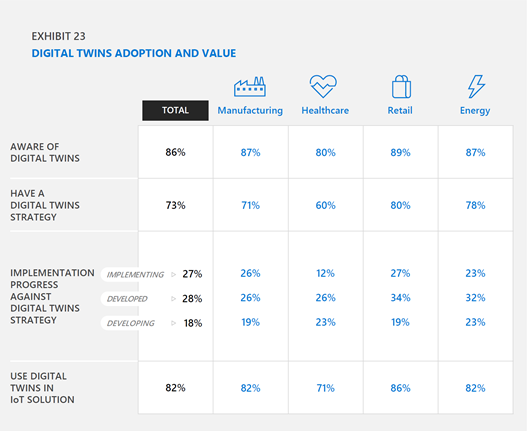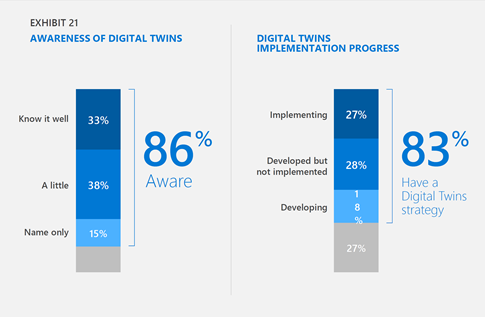For most companies and industries, technologies such as AI, Edge Computing and Digital Twins are becoming part of their solution, but they are all still relatively untapped in potential – especially Digital Twins. In this blog post, we look at what it is, why we should use it, the barriers we could face, and how Codit could help you to implement it.
According to the 2021 IoT Signals Report, 50% of companies studied use AI for maintenance or audio/visual processing, while Edge Computing is used for smart buildings. Although industries such as retail are rapidly implementing Digital Twins into their IoT strategy, many are still in the development stage: of those companies using Digital Twins, 28% are in the learning stage and about half in PoC. Only 11% have reached the use phase. The technology, although on the rise, is still relatively unused in many areas.
What is it?
Azure Digital Twins is an IoT platform used to create a digital representation of real-world things, places, business processes, and people. Its purpose is to simulate and thus understand, control and analyze real-world operations, costs, products and experiences through an open-modeling language. Using IoT sensors, log files and other information, it collects real-time data to replicate assets, which are then combined with AI analytics tools virtually. The digital assets can be created even before the physical.
Why use it?
Simulations are useful to most industries, but real-life opens are expensive and time-consuming. Digital Twins can be used to model anything important to your organization — both inexpensively and efficiently. Mostly, this is in the form of simplifying processes such as optimization. It also offers predictive maintenance, improved productivity, faster production times, testing and improved customer satisfaction.
One example cited in the IoT Signals Report is its use in the US water and power technologies industry. There, it is being used to simulate a digital 3D point cloud of manufactured parts. When the digital twin is optimized mathematically, it creates better and more configurations for the industry, much more efficiently.
Digital Twins can also help businesses to unlock actionable insights with powerful query APIs, and to integrate with Azure data, analytics, and AI services.
Where is it currently being used?
Digital Twins can be used to model everything from buildings, to farms, to railways – even to entire cities. Although traditionally associated with manufacturing, it is currently mostly being used in retail, with 86% of retail organizations using it in their IoT strategy. They also have the highest level of implementation against their Digital Twins strategies (27% – see below). This is compared to lower amounts in the healthcare and manufacturing industries. See the example below:

IoT signals report (IoT Signals Edition 3 (microsoft.com))
For those who use IoT in their strategies, 86% say they are aware of Digital Twins, but only a third know anything substantial. As the below example shows, however, those who do understand it are using it. Of those companies using Digital Twins, 39% consider it a core component, and 43% call it a secondary component.

IoT signals report (IoT Signals Edition 3 (microsoft.com))
Conclusion
Often it is hard to implement new technologies into an organization due to limitations in pricing and other formalities such as a lack of knowledge. Moreover, technologies such as Edge Computing and Digital Twins also require more testing in PoC to prove their value. The need, therefore, is established: it is a matter of time, however, before it becomes commonplace.
Used correctly however, Digital Twins could mark a new stage for most industries. The market for it is expected to grow to 36 billions dollars by 2025, in comparison to 4 billion dollars in 2019, as more and more companies embrace IoT technologies.
For more information about Digital Twins, be sure to attend Codit’s upcoming virtual workshop: Make Your Spaces Smart with Digital Twins.
Subscribe to our RSS feed